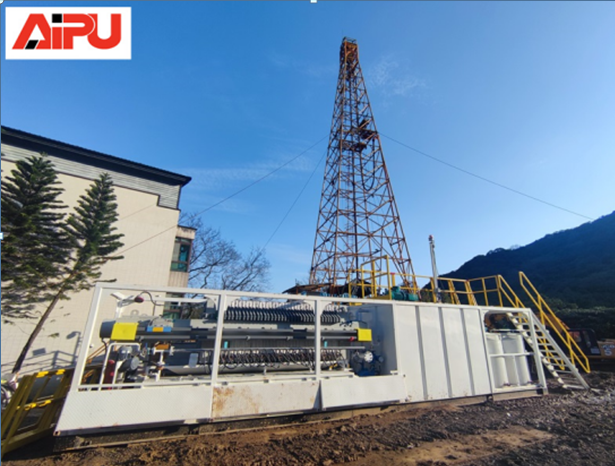Optimize Output through Effective Solids Management
Drilling operations in mountainous regions present a unique set of challenges, and having cutting - edge solids control equipment is crucial. This article will explore the key aspects of such equipment tailored for mountainous drilling.
Unique Challenges in Mountainous Drilling
Mountainous terrains are characterized by uneven ground, limited access, and harsh environmental conditions. The rough topography makes it difficult to transport and install large - scale equipment. Additionally, the cold climate and high altitudes can affect the performance of machinery. In mountain drilling, the drilling fluid often contains a high proportion of abrasive solids due to the rocky nature of the terrain. These solids can cause significant wear and tear on the drilling equipment if not properly removed. Solids control equipment must be designed to handle these specific challenges to ensure the efficiency and longevity of the drilling operation.
Cutting - Edge Features of Solids Control Equipment
Modern solids control equipment for mountainous drilling comes with several advanced features. Firstly, they are often designed to be compact and lightweight, making them easier to transport and install in remote mountain locations. Some equipment uses modular designs, allowing for quick assembly and disassembly. In terms of performance, these devices are equipped with high - efficiency separation technologies. For example, shale shakers use advanced vibration systems to effectively separate large solids from the drilling fluid. Hydrocyclones are designed with precise geometries to optimize the separation of fine solids. Moreover, the equipment is built with corrosion - resistant materials to withstand the harsh mountain environment.
Benefits of Using Advanced Equipment
Employing cutting - edge solids control equipment brings numerous benefits. By effectively removing solids from the drilling fluid, the equipment reduces the wear on drilling bits and other components, thus extending their service life. This leads to significant cost savings in terms of equipment replacement and maintenance. Improved solids control also enhances the quality of the drilling fluid, which in turn improves the drilling efficiency. A cleaner drilling fluid allows for better lubrication and cooling of the drill bit, enabling faster and more accurate drilling. Additionally, it helps to minimize the environmental impact of the drilling operation by reducing the amount of solid waste generated.
Future Trends in Mountainous Drilling Solids Control
The future of solids control equipment for mountainous drilling is likely to see further advancements. There will be a greater emphasis on automation and remote monitoring. This will allow operators to control and adjust the equipment from a distance, improving safety and efficiency, especially in difficult - to - reach mountain areas. The development of more energy - efficient equipment is also on the horizon. New materials and technologies will be used to reduce the power consumption of the solids control systems. Furthermore, there will be an increased focus on integrating different types of solids control equipment into a more comprehensive and seamless system for better overall performance.
In conclusion, the right solids control equipment is essential for successful mountainous drilling. With continuous innovation and improvement, the equipment will better meet the unique challenges of mountain drilling and contribute to more efficient and sustainable operations.

Unique Challenges in Mountainous Drilling
Mountainous terrains are characterized by uneven ground, limited access, and harsh environmental conditions. The rough topography makes it difficult to transport and install large - scale equipment. Additionally, the cold climate and high altitudes can affect the performance of machinery. In mountain drilling, the drilling fluid often contains a high proportion of abrasive solids due to the rocky nature of the terrain. These solids can cause significant wear and tear on the drilling equipment if not properly removed. Solids control equipment must be designed to handle these specific challenges to ensure the efficiency and longevity of the drilling operation.
Cutting - Edge Features of Solids Control Equipment
Modern solids control equipment for mountainous drilling comes with several advanced features. Firstly, they are often designed to be compact and lightweight, making them easier to transport and install in remote mountain locations. Some equipment uses modular designs, allowing for quick assembly and disassembly. In terms of performance, these devices are equipped with high - efficiency separation technologies. For example, shale shakers use advanced vibration systems to effectively separate large solids from the drilling fluid. Hydrocyclones are designed with precise geometries to optimize the separation of fine solids. Moreover, the equipment is built with corrosion - resistant materials to withstand the harsh mountain environment.
Benefits of Using Advanced Equipment
Employing cutting - edge solids control equipment brings numerous benefits. By effectively removing solids from the drilling fluid, the equipment reduces the wear on drilling bits and other components, thus extending their service life. This leads to significant cost savings in terms of equipment replacement and maintenance. Improved solids control also enhances the quality of the drilling fluid, which in turn improves the drilling efficiency. A cleaner drilling fluid allows for better lubrication and cooling of the drill bit, enabling faster and more accurate drilling. Additionally, it helps to minimize the environmental impact of the drilling operation by reducing the amount of solid waste generated.
Future Trends in Mountainous Drilling Solids Control
The future of solids control equipment for mountainous drilling is likely to see further advancements. There will be a greater emphasis on automation and remote monitoring. This will allow operators to control and adjust the equipment from a distance, improving safety and efficiency, especially in difficult - to - reach mountain areas. The development of more energy - efficient equipment is also on the horizon. New materials and technologies will be used to reduce the power consumption of the solids control systems. Furthermore, there will be an increased focus on integrating different types of solids control equipment into a more comprehensive and seamless system for better overall performance.
In conclusion, the right solids control equipment is essential for successful mountainous drilling. With continuous innovation and improvement, the equipment will better meet the unique challenges of mountain drilling and contribute to more efficient and sustainable operations.








